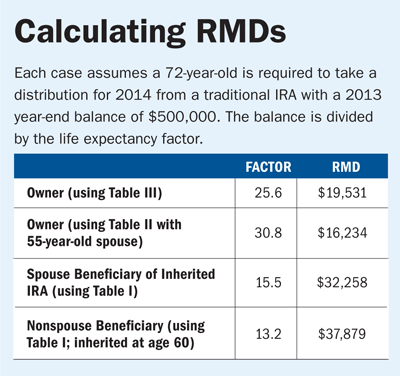Avoid This RMD Tax Trap
Follow the wrong set of calculation rules for IRA required minimum distributions and you could get socked with a big penalty.

Everyone who owns a traditional IRA must eventually pay Uncle Sam income tax on required minimum distributions. But the rules for calculating RMDs differ depending on whether you're the original owner, a spouse beneficiary or a nonspouse heir. The rules have one thing in common: If you don't take out enough money, the IRS could sock you with a hefty penalty.
Original owner. When the original owner of a traditional IRA hits age 70 1/2, he must start taking distributions. The deadline for the first RMD is April 1 of the year after he turns 70 1/2. All subsequent RMDs must be taken by December 31 of each tax year. To avoid a big tax bite by taking the first and second distributions in the same year, Mike Piershale, president of Piershale Financial Group, in Crystal Lake, Ill., says "most people will take the first distribution in the year they turn 70 1/2." If you fail to take an RMD on time, the IRS will sock you with a 50% penalty of the missed amount—if the RMD is $10,000, that's a $5,000 penalty.

To calculate the RMD, take the account balance on December 31 of the previous tax year and divide that by a factor from IRS Table III, called the Uniform Lifetime Table (find the tables in IRS Publication 590). That factor is based on your remaining life expectancy. (In this story, each RMD calculation is for 2014 and assumes a 2013 year-end balance of $500,000.)
From just $107.88 $24.99 for Kiplinger Personal Finance
Become a smarter, better informed investor. Subscribe from just $107.88 $24.99, plus get up to 4 Special Issues

Sign up for Kiplinger’s Free Newsletters
Profit and prosper with the best of expert advice on investing, taxes, retirement, personal finance and more - straight to your e-mail.
Profit and prosper with the best of expert advice - straight to your e-mail.
The RMD for a 72-year-old using a life expectancy factor of 25.6, for instance, would be $19,531. An 80-year-old uses a factor of 18.7, resulting in an RMD of $26,738—about $7,200 more.
Singles and most married owners consult Table III. The exception is an owner with a spouse who is more than ten years younger and is the IRA's sole beneficiary. He uses Table II, the Joint Life and Last Survivor Table. "You don't have to take the money out as fast," says Travis Sollinger, a financial planner at Fort Pitt Capital Group, in Pittsburgh. The RMD of a 72-year-old husband with a 55-year-old wife would be about $3,300 less than the 72-year-old above (see table).
Spouse beneficiary. A spouse has two options when inheriting an IRA: Roll the money into her own IRA, or remain a named beneficiary of the inherited IRA.
If she rolls the account into her own IRA, she won't start RMDs until she turns 70 1/2, and she will use Table III. This is the route most spouses take, Sollinger says.
A widow who stays a named beneficiary won't take RMDs until her late husband would have turned 70 1/2. Then, she must take distributions based on her life expectancy. She uses Table I, which all beneficiaries use. But she has an advantage over nonspouse beneficiaries (described next). Each year, says Jeffrey Levine, IRA technical consultant for Ed Slott and Co., which provides IRA advice, "the spouse gets to recalculate life expectancy, which results in smaller distributions."
But the RMDs are lower as an owner. Say the widow is 75. If she keeps an inherited IRA, she uses a factor of 13.4. If she rolls the money into her IRA, the factor is 22.9, and she will take out about $15,500 less than the widow with the inherited IRA (read When a Surviving Spouse Inherits an IRA).
Nonspouse beneficiary. A nonspouse heir starts RMDs the year after the original owner dies and consults Table I for his first RMD. For each subsequent year, the nonspouse heir subtracts one from that factor.
If the nonspouse heir is 55 at his first RMD, he will use a factor of 29.6 from Table I. For his second RMD, he uses 28.6, instead of the table's factor of 28.7 for age 56. By the time he reaches age 75, he will use a factor of 9.6 instead of the table's 13.4. At age 75 in 2014, his RMD will be $52,083, about $15,000 more than if he were a spousal heir who remains a beneficiary.
Nonspouse heirs who mistakenly take RMDs as if they were an owner or a spousal beneficiary will take out too little. They'll owe the 50% penalty on the shortfall.
Haven't yet filed for Social Security? Create a personalized strategy to maximize your lifetime income from Social Security. Order Kiplinger’s Social Security Solutions today.
Profit and prosper with the best of Kiplinger's advice on investing, taxes, retirement, personal finance and much more. Delivered daily. Enter your email in the box and click Sign Me Up.

-
 Holiday Tax Scams: 'Tis the Season to be Wary
Holiday Tax Scams: 'Tis the Season to be WaryTax Scams Navigating tax tricks of the holiday season may be daunting, but don't let that destroy your festive spirit
-
 Metro by T-Mobile Is Giving Away This Samsung Galaxy A16: Which Plans Are Eligible?
Metro by T-Mobile Is Giving Away This Samsung Galaxy A16: Which Plans Are Eligible?Metro by T-Mobile is offering free Samsung Galaxy A16 phones on eligible plans right now. Here’s how the deal works.
-
 I Drive and Collect Classic Cars: Here’s How I Got Started
I Drive and Collect Classic Cars: Here’s How I Got StartedAre classic cars a hobby or an investment strategy — or both? Either way, the vintage car scene is much cooler and more affordable than you think.
-
 457 Plan Contribution Limits for 2026
457 Plan Contribution Limits for 2026Retirement plans There are higher 457 plan contribution limits in 2026. That's good news for state and local government employees.
-
 Medicare Basics: 12 Things You Need to Know
Medicare Basics: 12 Things You Need to KnowMedicare There's Medicare Part A, Part B, Part D, Medigap plans, Medicare Advantage plans and so on. We sort out the confusion about signing up for Medicare — and much more.
-
 The Seven Worst Assets to Leave Your Kids or Grandkids
The Seven Worst Assets to Leave Your Kids or Grandkidsinheritance Leaving these assets to your loved ones may be more trouble than it’s worth. Here's how to avoid adding to their grief after you're gone.
-
 SEP IRA Contribution Limits for 2026
SEP IRA Contribution Limits for 2026SEP IRA A good option for small business owners, SEP IRAs allow individual annual contributions of as much as $70,000 in 2025, and up to $72,000 in 2026.
-
 Roth IRA Contribution Limits for 2026
Roth IRA Contribution Limits for 2026Roth IRAs Roth IRAs allow you to save for retirement with after-tax dollars while you're working, and then withdraw those contributions and earnings tax-free when you retire. Here's a look at 2026 limits and income-based phaseouts.
-
 SIMPLE IRA Contribution Limits for 2026
SIMPLE IRA Contribution Limits for 2026simple IRA For 2026, the SIMPLE IRA contribution limit rises to $17,000, with a $4,000 catch-up for those 50 and over, totaling $21,000.
-
 457 Contribution Limits for 2024
457 Contribution Limits for 2024retirement plans State and local government workers can contribute more to their 457 plans in 2024 than in 2023.
-
 Roth 401(k) Contribution Limits for 2026
Roth 401(k) Contribution Limits for 2026retirement plans The Roth 401(k) contribution limit for 2026 has increased, and workers who are 50 and older can save even more.